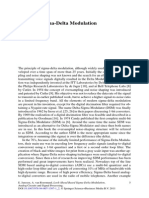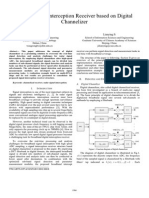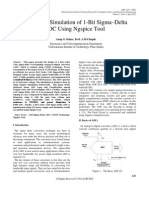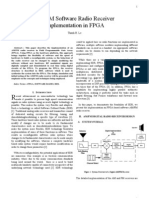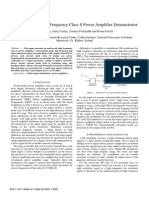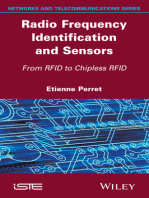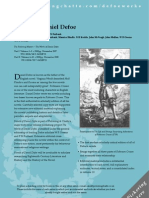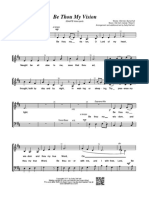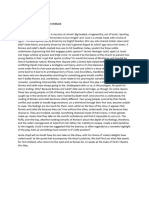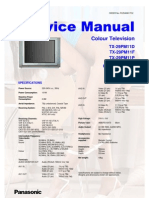Optimized Digital Filter Architectures For Multi-Standard RF Transceivers
Optimized Digital Filter Architectures For Multi-Standard RF Transceivers
Uploaded by
vvigyaCopyright:
Available Formats
Optimized Digital Filter Architectures For Multi-Standard RF Transceivers
Optimized Digital Filter Architectures For Multi-Standard RF Transceivers
Uploaded by
vvigyaOriginal Title
Copyright
Available Formats
Share this document
Did you find this document useful?
Is this content inappropriate?
Copyright:
Available Formats
Optimized Digital Filter Architectures For Multi-Standard RF Transceivers
Optimized Digital Filter Architectures For Multi-Standard RF Transceivers
Uploaded by
vvigyaCopyright:
Available Formats
Journal of Theoretical and Applied Information Technology
th
20 July 2014. Vol. 65 No.2
2005 - 2014 JATIT & LLS. All rights reserved.
ISSN: 1992-8645
www.jatit.org
E-ISSN: 1817-3195
OPTIMIZED DIGITAL FILTER ARCHITECTURES FOR
MULTI-STANDARD RF TRANSCEIVERS
1
R.LATHA, 2Dr.P.T.VANATHI
Department of Electronics &Communication Engineering,
Christ University-Faculty of Engineering, Bangalore-560 060, India.
2
Department of Electronics & Communication Engineering,
P.S.G. College of Technology, Coimbatore- 641 004, India.
E-mail: 1 lathar_26@rediffmail.com , Mobile: 07829198800
2
ptvani@yahoo.com , Mobile: 09486438516
ABSTRACT
This paper addresses on two different architectures of digital decimation filter design of a multi-standard
Radio Frequency (RF) transceivers. Instead of using single stage decimation filter network, the filters are
implemented in multiple stages using FPGA to optimize the area and power. The proposed two types of
decimation filter architectures reflect the considerable reduction in area & power consumption without
degradation of performance. The filter coefficients are derived from MATLAB and the filter architectures
are implemented and tested using Xilinx SPARTAN FPGA .The Xilinx ISE 9.2i tool is used for logic
synthesis and the Xpower analysis tool is used for estimating the power consumption. First, the types of
decimation filter architectures are tested and implemented using conventional binary number system. Then
the two different encoding schemes namely i.e. Canonic Signed Digit (CSD) and Minimum Signed Digit
(MSD) are used for filter coefficients and then the architecture performances are tested .The results of CSD
and MSD based architectures show a considerable reduction in the area & power against the conventional
number system based filter design implementation.
Keywords: Digital Transceiver, Multi-rate Digital Filter, Multistage Decimation Filter, FPGA, Area
Reduction, Low Power Design.
1. INTRODUCTION
RF communication transceivers emphasizes both
higher integration to meet consumer demand of
low-cost,
low-power,
less
area personal
communication devices and the ability to adapt to
Multiple Communication Standards. Higher
integration can be achieved by using receiver
architectures and circuit techniques that eliminate
the need for external components. Receiver
architecture that performs channel select filtering
based on-chip at baseband allows for
the
programmability necessary to adapt to Multiple
Communication Standards[3]. In audio applications
of wireless transceivers, the use of oversampled
Sigma Delta Analog to Digital (-ADC)
converter has become popular because of its high
resolution, improved performances and flexibility
in selection of sampling rates. Consider an analog
input signal with maximum frequency of fx, which
is sampled by the oversampling Sigma Delta
Analog to Digital converter[4]. The -ADC
converter samples the input signal with rate much
greater than Nyquist rate 2fx.The oversampling
ratio of the -ADC is defined as M =fs/2fx,where
fs is the sampling rate of -ADC converter and
2fx is the Nyquist rate. Typical audio application
consists of an oversampled -ADC followed by a
decimation filter. The digital decimation filter is
used to perform filtering operation and sampling
rate down conversion so as to extract the original
signal band or the band of interest from the
oversampled -ADC. A programmable low-pass
digital decimation filter of a RF transceiver can
select a desired channel in the presence of both
strong adjacent channel interference and
quantization noise from the digitizing process.
Several literatures deal with the design issues of
decimation filters for wireless communication
transceivers. In this paper, a cascade CICHB.FIR
filter implementation of the decimation filter using
Conventional , CSD and MSD based multipliers are
addressed in detail. This paper is organized as
544
Journal of Theoretical and Applied Information Technology
th
20 July 2014. Vol. 65 No.2
2005 - 2014 JATIT & LLS. All rights reserved.
ISSN: 1992-8645
www.jatit.org
follows: Section 2 describes the digital receiver
architecture suitable for multi-standard operation.
Section 3 deals with the concepts of decimation
process. Section 4 presents the two different
multistage decimation filter architectures and types
of filters used for implementation of each stage. In
Section 5 Canonic Signed Digit (CSD) and
Minimum Signed Digit (MSD) representation are
explained in detail[8]. Section 6 provides the
simulation results of the various types of
decimation filter architectures. Finally Section 7
describes the conclusion and future work.
2. DIGITAL RECEIVER ARCHITECTURE
This section deals with the digital receiver
architecture, which emphasizes high integration and
E-ISSN: 1817-3195
multi-standard capability. High integration can be
achieved by utilizing a receiver architecture that
performs base band channel select filtering on-chip.
This enhances the programmability to different
dynamic range, linearity and signal bandwidth so as
to meet the requirements of multiple RF standards.
Typical block diagram of a digital transceiver is
shown in Figure 1. An overview of a digital
receiver will readily confirm that its main task is to
take a signal sampled at a high rate, down convert it
and filter it-through low-pass filter and then
decimate it and finally format it into one or more of
several forms. After demodulation, this signal is
converted back to analog form and then applied to
power amplifier and loudspeaker.
Figure 1: Architecture Of Digital Transceiver
The input analog signal is converted to digital
form with the aid of the A/D converter. A wide
band, high dynamic range sigma-delta modulator
can be used to digitize both the desired signal and
potentially stronger adjacent channel interferences.
Next, this signal compromising of ones and zeros is
applied to a digital Mixer, just as in the case of
analog receiver. Only at this time, the signal is
applied to two Mixers driven by digital In-phase (I)
and Quadrature (Q) components of a local oscillator
signal which in turn is provided by a digital
frequency synthesizer. In essence, the input signal
is multiplied with the sine and also with the cosine
output of the local oscillator. Just as in the case of
the analog receiver, the output of the Mixer consists
of sum and difference frequencies extending the
way up in the sampled data spectrum. To remove
the higher order components and to recover only
the baseband signal, the signal is passed through a
decimating low pass filter. This digital filter has the
property of reducing the sample rate of the input
signal by some factor(decimation factor) , which
can be programmed to be as low as 1 or as high
as 16,384.The filter output signal is formatted and
this is made available in one or more of several
forms. As far as the demodulator function is
concerned, it is best performed digitally in a DSP
processor outside the digital receiver chip.
Demodulator is followed by a D/A converter and
speaker to complete the analogy between the analog
and digital receivers.
3. DECIMATION PROCESS
To reconstruct a signal from its sample values, a
band-limited signal only need to be sampled at a
rate in excess of the Nyquist rate. Speech or low
bandwidth signals may be sampled well above their
Nyquist rate to bypass problems associated with the
low rate analog to digital conversion. This is
achieved using Sigma Delta A/D converter(ADCs) in the digital receivers. One of the key
features of Sigma Delta A/D converter is that the
modulator is over sampled compared to the
545
Journal of Theoretical and Applied Information Technology
th
20 July 2014. Vol. 65 No.2
2005 - 2014 JATIT & LLS. All rights reserved.
ISSN: 1992-8645
www.jatit.org
expected output sample rate. Decimation is an
important component of over sampled analog to
digital conversion (- ADCs). A higher order
decimation filter is used to convert the over
sampled signal into usable baseband signal. The
decimation process simply reduces the output
sample rate while retaining the necessary
information. It transforms the digitally modulated
signal from short words occurring at high sampling
rate to longer words at Nyquist rate. To extract the
signal information, the signal must be first downconverted to base band. A multi-stage decimation
filter is used to perform this function.
As far as initial stage of decimation is concerned,
the word rate decreases to about four times the
Nyquist rate. In all these cases, high decimation
rates are required to reduce the output bandwidth
which can be processed with conventional
hardware. Due to over sampled - ADCs , only
small fraction of the total noise power falls in the
frequency band of interest.The noise power outside
the signal band can be greatly attenuated with a
digital low pass decimation filter following the ADC. Decimation is often performed in several
stages instead of a single stage. This leads to higher
decimation factor in the first filter stage as
compared with decimation filters of similar input
and output data word lengths in the consecutive
stages. However, the word length differs between
the consecutive stages. This is especially important
for ADCs, as the input to the decimator may be
only one bit while the output precision can be, say,
16 bits or more. Multistage decimation filter
architecture reduces the overall complexity in terms
of area and power at each stage of filter design[10].
4. MULTISTAGE DECIMATION FILTER
The sampling rate is down converted from the
oversampled rate of sigma-delta modulator to a data
rate that can be conveniently processed by existing
DSP processors using decimation filters. This
minimizes the power consumption of DSP
processors for demodulation and equalization. The
purpose of decimation filter is to remove all the
out-of-band signals and noise and to reduce the
sampling rate from oversampled frequency of the
- ADC to Nyquist rate of the channel [7]. The
decimation filter consists of a low-pass filter and a
down-sampler. It is possible to perform noise
removal and down conversion with a single FIR
filter stage. The filter order N of FIR low-pass filter
is given by eqn. (1), where D is a function of the
required ripples p and s in the pass-band and
E-ISSN: 1817-3195
stop-band respectively, Fs is the sampling
frequency and f is the width of transition band.
N D( p, s) (FS/ f)
(1)
As the - ADCs are oversampled, the transition
band is small relative to the sampling frequency
leading to excessively large filter orders and this
leads to a lot of multiplication operations. The
power consumption of the filter depends on the
number of taps as well as the rate at which it
operates. So computational complexity is high for
single stage implementation of decimation filter
and consumes more power. Implementing
decimation filter in several stages reduces the total
number of filter coefficients. Subsequently, the
hardware complexity and computational effort are
reduced in multistage approach. This will result in
less area and low power consumption. A multistage
decimation filter system consists of a cascaded
structure of several single stage decimation filter
systems. The ith stage of multistage system
performs decimation by a factor of Ri such that
the overall decimation factor R is given by the
eqn. (2)
P
R= Ri,
(2)
i=1
Where P is the total
number of stages of
multistage decimation filters. The individual filter
of each stage is designed within the frequency band
of interest in order to prevent aliasing in the overall
decimation process. The performance of a
decimation filter depends on the filter architecture
and the order of each stage of a multistage
decimator. FIR filters are widely used in decimators
because of its linear phase characteristics. Multiple
contributions are proposed in previous works for
multi-standard multi stage digital filters for
decimation and channel selection. Multistage
decimation reduces the overall complexity of
system by decomposing the decimation factor into
several sub factors. Thus, each stage requires lower
order filters. Moreover, after four to five stages, the
filter complexity is not further reduced. Therefore,
a trade off between the number of stages and
complexity must be achieved.
FIR filter are used in down converters because
some modulation schemes requires linear phase. In
wireless communication devices, the battery life
must be maximized. Therefore, high performance
blocks with low power consumption and small area
are required [1]. The implementation of decimation
filter for multiple standards on a single device is
very demanding in terms of area and power. With
546
Journal of Theoretical and Applied Information Technology
th
20 July 2014. Vol. 65 No.2
2005 - 2014 JATIT & LLS. All rights reserved.
ISSN: 1992-8645
www.jatit.org
an efficient decomposition of decimation factor
considering common blocks between different
communication standards, it is possible to have an
efficient design. Thus, few different blocks could
be implemented in a configurable fashion.Two
different filter architectures used in this paper are
described in the following sections in detail.
4.1. Architecture I:
Decimation Filter with Conventional MAC Unit
E-ISSN: 1817-3195
In this architecture, decimation filter is
implemented using two filter stages with a overall
decimation factor of 32. The decimation filter
architecture consists of first stage representing High
Order Decimation Filter (HDF) and second stage
representing Corrector Finite Impulse Response
(FIR) filter and implemented using conventional
binary number system with conventional MAC unit
as shown in figure 2.
Figure 2: Two Stage Decimation Filter With Conventional MAC Unit
4.1.1. Cascaded Integrator Comb (CIC) Filter
The first filter section is called the HDF and it is
normally optimized to perform decimation by large
factors. It implements a low pass filter function
using only adders and delay elements instead
of a large number of multiplier/accumulators that
would be required using a standard FIR filter. An
efficient architecture of HDF stage belongs to a
class of multi-rate multiplier-less systems referred
to as Cascade of Integrators-Comb (CIC) filters[6].
In fact, in its recursive form, the CIC filter is
multiplier less and presents low complexity
properties. The fifth order CIC filter structure is
shown in figure 3. It is constructed using only
integrators and differentiators. Blocks R represents
the decimator .The CIC filter design approach
consists of 5 stages of Integrator section followed
by a 5 stages of differentiators. The cascaded
structure of integrators and combs provides a better
solution for low power CIC filters as shown by
figure 3.
Figure 3: Fifth Order Cic Filter Structure
The integrator and the comb filter operations are
performed using registers and adders only. Figure 4
shows the equivalent digital circuit representation
of the integrator stages. Each accumulator is
implemented as an adder followed by a register in
the feed forward path. The integrator is clocked by
the sample clock, CK_IN . The output of the
Integrator section is latched on to the decimation
register by CK_DEC. The output of the decimation
register is passed to the Comb Filter Section. The
Comb section consists of five cascaded comb
filters. Each Comb filter section calculates the
difference between the current and previous
integrator output. Each comb filter consists of a
register which is clocked by CK_DEC followed
by an subtracter where the subtracter calculates the
difference between the input and output of the
register. Figure 5 describes the equivalent digital
circuit representation of the 5- stage comb filter.
547
Journal of Theoretical and Applied Information Technology
th
20 July 2014. Vol. 65 No.2
2005 - 2014 JATIT & LLS. All rights reserved.
ISSN: 1992-8645
www.jatit.org
E-ISSN: 1817-3195
Figure 4: Digital Circuit Implementation Of 5-Stage Integrator
Figure 5: Digital Circuit Implementation Of 5-Stage Comb Filter Section
4.1.2. Characteristics of CIC filter
The integrator section of CIC filter consists of N
ideal digital integrator stages operating at high
sampling rate, fs. Each stage is implemented as a
one-pole filter with a unity feedback coefficient.
The system function for a single integrator is given
by eqn. (3).
HI (z) =1/(1-z-1)
(3)
The comb section operates at the low sampling
rate fs/R, where R is the integer rate change factor.
This section consists of N comb stages with a
differential delay of M samples per stage. The
differential delay is a filter design parameter used
to control the filters frequency response. In
practice, the differential delay is usually held at M
= 1 or 2. The system function for a single comb
stage referenced to high sampling rate is denoted by
eqn. (4).
HC (z) = (1-z-RM)
Where R - Decimation ratio
M - Differential delay
N - No. of stages
(4)
It follows from eqn. 3and eqn. 4 that the system
function for the composite Nth order CIC filter
referenced to the high sampling rate, fs is denoted
by eqn. 5 as
H(z) = HIN(z) * HCN(z) = (1 - z-RM)N / (1-z-1)N
= [ z-k]N
(5)
where k ranges from 0 to RM-1
It is implicit from the last form of the
system function that the CIC -HDF filter is
functionally equivalent to a cascade of N uniform
FIR filter stages[9].
4.1.3. Corrector FIR Filter
The second filter stage in the top level block
diagram of architecture I is a corrector Finite
Impulse Response (FIR) filter which performs the
final shaping of the signal spectrum and suppresses
the aliasing components in the transition band of
the HDF. This enables the Decimation filter to
implement filters with narrow pass bands and sharp
transition bands. The Corrector FIR filter structure
used for architecture I is shown in figure 6.The FIR
is implemented in a transversal structure using a
single multiplier/accumulator (MAC) and RAM for
548
Journal of Theoretical and Applied Information Technology
th
20 July 2014. Vol. 65 No.2
2005 - 2014 JATIT & LLS. All rights reserved.
ISSN: 1992-8645
www.jatit.org
storage of data and filter coefficients. The corrector
FIR is designed with the decimation factor of
two[2]. The 16-bit output of the HDF output
register is written into the data RAM on the rising
E-ISSN: 1817-3195
edge of CK_DEC. The Coefficient RAM stores the
coefficients for the current FIR filter being
implemented. The coefficients are loaded into the
Coefficient RAM over the control bus.
Figure 6: Corrector FIR Filter Using MAC Unit
4.2. Architecture II
Cascaded Multistage Decimation Chain
The decimation filter is a block that reduces the
data rate from IF to base band domain. Different
communication standards require large factor of
decimation resulting in large orders of filter
networks. Multistage decimation reduces the
overall complexity of system, by decomposing the
decimation factor in to several sub factors. Thus,
each stage requires lower order filters. However,
the use of several stages will increase hardware
complexity. FIR filter are used in down converters
because some modulation schemes requires linear
phase[12]. In wireless communication transceivers,
the battery life must be maximized. Therefore, high
performance blocks with low power consumption
and small area are required. The implementation of
decimation filter for each standard on a single
device is very demanding in terms of overall area
and power dissipation. However, with an efficient
decomposition of decimation factor and considering
549
Journal of Theoretical and Applied Information Technology
th
20 July 2014. Vol. 65 No.2
2005 - 2014 JATIT & LLS. All rights reserved.
ISSN: 1992-8645
www.jatit.org
common blocks between different communication
standards, it is possible to have an efficient design
of multi-standard transceivers. Thus, few different
blocks could be implemented in a configurable
fashion to meet the multi-standard filter circuits
requirement.
4.2.1. Decimation Chain Structure
Figure 7 shows the Cascaded Multistage
Decimation Chain architecture for two different
standards with the decimation factors of 8 and 32.
The aim of this architecture is to reduce
multiplication operations. To reach this goal,
E-ISSN: 1817-3195
multiplier-less comb filters are used for the first
stage similar to architecture I. On simulations, the
last two stages of each standard cannot be comb
filters, because they dont remove the inband noise
level sufficiently. Thats why, it was decided to use
half band filters for the two last stages. They
exhibited good results and excellent out-of-band
signal attenuation. The proposed architecture II
supports three comb filter stages and 4 stages of
half band filters to meet multi-standard
requirements. Since the first comb filter stage is
used commonly for both the standards, this
architecture considerably reduces the area and
power of the multi-standard transceiver.
Figure 7: Cascaded Multistage Decimation Chain Architecture
4.2.2. CIC Filter Structure
The fifth order CIC filter structure resembles as
that of architecture I but the implementation of CIC
filter integrators and differentiators stages of
architecture II differs from architecture I. Figure 8
shows the basic integrator stage of CIC filter used
in this architecture- its Z transform and its
equivalent digital circuit in HDL. Thus the single
accumulator (Integrator) unit is implemented in
HDL using 14-bit adder and a register by avoiding
complex multiplexer stages ,when compared with
architecture I. In a similar fashion, the differentiator
(Comb filter) stage of CIC filter in Z domain and its
digital equivalent circuit are represented as shown
in figure 9. Thus the comb stage is designed in
HDL using a subtractor and a register networks.
This architecture results in a considerable reduction
in area and power ,when compared to the first
architecture. Simulation environment states that
further reduction in area and power can be achieved
by changing the encoding scheme of filter
coefficients from conventional binary number
system to Canonic Signed Digit (CSD) and
Minimum Signed Digit (MSD) Number systems.
Figure 8: Accumulator In Z-Transform And Its Digital Circuit Implementation
550
Journal of Theoretical and Applied Information Technology
th
20 July 2014. Vol. 65 No.2
2005 - 2014 JATIT & LLS. All rights reserved.
ISSN: 1992-8645
www.jatit.org
E-ISSN: 1817-3195
Figure 9: Differentiator In Z-Transform And Its Digital Circuit Implementation
4.2.3. Half Band Filter
The CIC filter is followed by an half band FIR
filter for further down-sampling .The half band FIR
filter is used instead of another CIC due to the fact
that the pass band of CIC consists of distortions
and the half band FIR can be designed in such a
way that its frequency response compensates for the
distortions created by CIC stages. Since the downsampling rate of half band filter is chosen to be 2,
special type of symmetric coefficients type FIR
filter can be used for the architecture II- meaning
that the coefficients of an odd N tap (N-1 order)
half band FIR can be represented by Ceil [(N-1)/4]
+1 numbers[11]. The half band filter significantly
reduces the hardware resources needed. The half
band filter structure is shown in figure 10.The order
of the half band filter used in this design is 14(15
taps) with the filter coefficients quantized for 8-bit
precision.
Figure 10: Structure Of Half Band Filter
5. CO-EFFICIENT REALIZATION USING
CSD AND MSD REPRESENTATIONS
The CSD representation is a radix-2 signed digit
system with the digit set (1,0, _1). For any binary
number, the CSD representation is unique and it
satisfies the following two properties: first property
is that the number of non zero digits are minimal
and the second property is that adjacent two digits
can never be nonzero digits i.e. the product of
adjacent two digits will always be zero. This
representation is widely used in multiplier less
implementations of filter design with respect to
filter coefficients because it reduces the hardware
requirements due to the minimum number of nonzero digits. Any N digit number in CSD format has
at most (N+1)/2 non-zero digits thus requiring only
that much number of adders/ subtractors. On an
average, the number of non-zero digits in CSD is
reduced by 33%, when compared with the
conventional binary number system. To obtain the
CSD representation of a number, start processing
its binary representation from the least significant
digit to the most significant digit and replace
repeatedly all the sequences found as 011 by a
sequence 1001 with same number of digits[5].
The conversion table shown in Table 1 is used to
obtain the CSD number of a given binary number.
551
Journal of Theoretical and Applied Information Technology
th
20 July 2014. Vol. 65 No.2
2005 - 2014 JATIT & LLS. All rights reserved.
ISSN: 1992-8645
www.jatit.org
E-ISSN: 1817-3195
Table 1. Csd Conversion Table
State
0
0
0
0
1
1
1
1
Inputs
bi+1
0
0
1
1
0
0
1
0
bi
0
1
0
1
0
1
0
1
If the second property of CSD is relaxed, then it
leads to MSD representation. Although CSD
representation is optimal for one constant (filter
coefficient-in our case) and it provides unique
solution, it is not suitable for common subexpression procedures of multiple constants. As the
CSD representation is unique, it has received much
attention and there are many methods of converting
a given binary number into the CSD representation.
The uniqueness is important in terms of
mathematics but not in implementing hardware
units. In general, the MSD representation providing
multiple representations yielding the same value is
more flexible than the CSD representation. This
redundancy can result in smaller hardware units
than those generated from the CSD representation
provided appropriate MSD representation is
selected for each constant. Thus the MSD
representation is a superset of CSD number system
and it provides a number of forms.
The MSD number system is appropriate in
finding common sub expressions of multiple
constants, in case proper MSD representation is
selected for each constant to be synthesized. Since
the MSD number system has an effect on the
number of additions in the decomposed
multiplication block and the number of common
sub-expressions that can be eliminated, it has
significant bearing on the reduction of area and
power consumption. The advantage of using the
MSD representation for a coefficient results from
increasing the possibilities of sharing partial terms
between coefficients. This results from the fact that,
ci
0
1
0
-1
1
0
-1
0
Outputs
Next State
0
0
0
1
0
1
1
1
in general, there exist several alternatives to
represent a given coefficient in MSD.
Consequently, there are more ways to decompose
the coefficient with different partial terms that can
be shared with other coefficients.
6. SIMULATION RESULTS
The decimation filter design specification is
shown in Table 2.The input signal frequency is
chosen as 64 MHz and the decimation factors are
chosen to be 8 and 32 respectively for the multistandard structures. The pass band of the filter
circuit with the decimation factors of 8 and 32 will
be 8 MHz and 2 MHz respectively. The pass band
ripple and the stop attenuation are taken to be 0.001
and -60 dB. The filter circuit performance has been
tested first using Matlab and the filter co-efficients
are derived as per the given specifications of Table
2. For the implementation of decimation filter
architectures in Spartan FPGA, the filter
coefficients derived from Matlab are encoded in
conventional binary number system, CSD and MSD
representations. In both the architectures, the
overall multistage filter networks are implemented
on Xilinx Spartan FPGA .The area in terms of total
gate count is analyzed for the architectures and the
power analysis are carried out using the power
estimating tool Xilinx Xpower Analyzer. Table 3
shows the comparison results of both decimation
filter architectures in terms of total gate count,
Number of slices, LUTs, IOBs, flip-flops and
power consumption with respect to conventional,
CSD and MSD number systems.
Table 2. Decimation Filter Specification
Specification Parameters
Decimation Factor
Pass Band
Pass Band Ripple
Cut Off Frequency
Standard I
8
0 to 8MHz
0.001
8.4 MHz
552
Standard II
32
0 to 2MHz
0.001
2.4 MHz
Journal of Theoretical and Applied Information Technology
th
20 July 2014. Vol. 65 No.2
2005 - 2014 JATIT & LLS. All rights reserved.
ISSN: 1992-8645
www.jatit.org
Stop Band Attenuation
Output Word Length
E-ISSN: 1817-3195
-60 dB
16 bits
-60 dB
16 bits
Table 3. Comparison Of Decimation Filter Architectures
S.No.
1.
2.
Architecture Type
(I) Two Stage Decimation
Filter
(II) Cascaded Multistage
Decimation Chain
Number
System
Representation
Conventional
Number System
Total No. No.
Gate
of
of
Count Slices FF
17624 554 492
No. Logic IOB
of
LUT
822 770 207
Total
Power
(mW)
1278
4279
467
392
442
278
36
57.45
3.
(II) Cascaded Multistage
Decimation Chain
Canonic Signed 3986
Digit (CSD)
235
279
337
278
36
50.11
4.
(II) Cascaded Multistage
Decimation Chain
Minimum
Signed Digit
(MSD)
154
92
163
138
27
42.77
3172
Figure 11: Frequency Response Of CIC Filter
553
Journal of Theoretical and Applied Information Technology
th
20 July 2014. Vol. 65 No.2
2005 - 2014 JATIT & LLS. All rights reserved.
ISSN: 1992-8645
www.jatit.org
Figure 12: Frequency Response Of Half Band Filter
Figure 13: Frequency Response Of Decimation Filter
554
E-ISSN: 1817-3195
Journal of Theoretical and Applied Information Technology
th
20 July 2014. Vol. 65 No.2
2005 - 2014 JATIT & LLS. All rights reserved.
ISSN: 1992-8645
www.jatit.org
Figure 14: Filter Coefficients Of Decimation Filter
Figure 15: Simulation Result Of Five Stage Comb Filter Output
555
E-ISSN: 1817-3195
Journal of Theoretical and Applied Information Technology
th
20 July 2014. Vol. 65 No.2
2005 - 2014 JATIT & LLS. All rights reserved.
ISSN: 1992-8645
www.jatit.org
Figure 16: Simulation Result Of Half-Band Filter Using CSD Representation
Figure 17: Simulation Result Of Half-Band Filter Using MSD Representation
556
E-ISSN: 1817-3195
Journal of Theoretical and Applied Information Technology
th
20 July 2014. Vol. 65 No.2
2005 - 2014 JATIT & LLS. All rights reserved.
ISSN: 1992-8645
www.jatit.org
E-ISSN: 1817-3195
Figure 18: Simulation Result Of Decimation Filter For Standard I
Figure 19: Simulation Result Of Decimation Filter For Standard II
7. CONCLUSION
Both the decimation filter architectures use the
same CIC filter (Comb) network. Simulation results
reveals that the total gate count of the decimation
filter with MAC unit (two stage decimator) and
Cascaded
Multistage
Decimation
Chain
architectures are 17624 and 4279. Further reduction
in gate count can be achieved by using CSD and
MSD representations for half band filter
557
Journal of Theoretical and Applied Information Technology
th
20 July 2014. Vol. 65 No.2
2005 - 2014 JATIT & LLS. All rights reserved.
ISSN: 1992-8645
www.jatit.org
E-ISSN: 1817-3195
[8]
S.-M. Kim, J.-G. Chung, Parhi, K.K.,Low
Error Fixed-Width CSD Multiplier with
Efficient Sign
Extension
IEEE
Transactions on Circuits & Systems II:
Analog & Digital Signal Processing, Vol.
50, no. 12, Dec. 2003.
Y. Gao, J. Tenhunen, and H. Tenhunen, A
Fifth-Order Comb Decimation Filter for
Multistandard Transceiver
Applications, in Proc. Geneva, Switzerland,
May 2831, 2000, pp. III-89III-92.
S. Chu and C. S. Burrus,Multi-rate Filter
Designs using Comb Filters, IEEE
Transactions on Circuits Syst., vol. CAS-31,
no. 11, pp. 913924, Nov. 1984.
R. E. Crochiere and L.R.Rabiner, Multirate
Digital Signal Processing, Upper Saddle
River, NJ: Prentice-Hall, 1983.
E. B. Hogenauer, An Economical Class of
Digital
Filters
for
Decimation
and
Interpolation,IEEE Trans. Acoust., Speech,
signal Process., vol. ASSP-29, no. 2, pp. 155
162, Apr. 1981.
coefficients and it is identified to be 3986 and 3172
respectively. The power dissipation of the two stage
decimator and the Multistage Cascaded Chain
architectures are found to be 1278 mW and
57.45mW respectively. Using CSD and MSD
representation for half band filters show
considerable reduction in power dissipation of
Cascaded
Multistage
Decimation
Chain
architecture and it is found to be 50.11mW and
42.77 mW respectively. Future work focuses on
implementation of architectures using poly-phase
digital filters and hybrid filter structure capable of
supporting multi-standard applications.
[9]
[10]
REFERENCES
[11]
[1] Yu-Chi Tsao and Ken Choi Area Efficient
VLSI Implementation for Parallel Linear
Phase FIR Digital Filters of Odd Length
Based on Fast FIR Algorithm PP 371-375,
IEEE
Transactions on
Circuits &
Systems,vol. 59 NO. 6, JUNE 2012.
[2] Dong Shi and Ya Jun Yu Design of Linear
Phase FIR Filters with High Probability of
Achieving Minimum Number of Adders PP
126-135, IEEE Transactions on Circuits &
Systems, vol. 58 no. 1, January 2011.
[3] Shahana T . K, Babita ,R Jose Jacob and Sreela
Sasi Decimation Filter Design Toolbox for
Multi-Standard
Wireless
Transceivers
using
MATLAB
PP 154 -163,
International Journal of Signal Processing
5,2009.
[4]
Massimiliano Laddomada
Design of
Multistage Decimation
Filters
using
Cyclotomic
Polynomials: Optimization
and Design Issues, IEEE Transactions on
Circuits & Systems vol. 55, no. 7, August
2008.
[5] Guo-Ming Sung, Hsiang-Yuan Hsieh An
ASIC Design for Decimation Filter with CSD
RepresentationInternational Symposium on
Intelligent
Signal
Processing
&
Communication Systems Swisstel
Le
Concorde, Bangkok,Thailand,2008.
[6] R. A. Losada and R. Lyons, Reducing CIC
filter complexity, IEEE Signal Process.
Mag.,Vol. 23, no. 4, pp.124126, Jul., 2006.
[7] Ling Zhang, Vinay Nadig and Mohammed
Ismail, A High Order Multi-bit
Modulator for Multi-Standard Wireless
Receiver,IEEE
Midwest
International
Symposium on Circuits and Systems, pp. III379-382, 2004.
[12]
558
You might also like
- Authenticity of English in Asian Popular MusicNo ratings yetAuthenticity of English in Asian Popular Music14 pages
- Assignment 1.1 Assignment 1.1: CHAPTER 1 NotationNo ratings yetAssignment 1.1 Assignment 1.1: CHAPTER 1 Notation1 page
- International Journal of Engineering Research and Development (IJERD)No ratings yetInternational Journal of Engineering Research and Development (IJERD)4 pages
- Advanced Techniques For Digital Receivers - Nivin RNo ratings yetAdvanced Techniques For Digital Receivers - Nivin R40 pages
- Sigma-Delta ADC For Mobile Application: AbstractNo ratings yetSigma-Delta ADC For Mobile Application: Abstract4 pages
- FPGA-based Implementation of Efficient Sample Rate Conversion For Software Defined RadiosNo ratings yetFPGA-based Implementation of Efficient Sample Rate Conversion For Software Defined Radios5 pages
- Novel Multi-Stage Transmultiplexing Digital Down Converter For Implementation of Rfid (Iso18000-3 Mode 2) Reader/WriterNo ratings yetNovel Multi-Stage Transmultiplexing Digital Down Converter For Implementation of Rfid (Iso18000-3 Mode 2) Reader/Writer5 pages
- The Fpga As A Flexible and Low-Cost Digital Solution For Wireless Base StationsNo ratings yetThe Fpga As A Flexible and Low-Cost Digital Solution For Wireless Base Stations16 pages
- Benefits of Delta-Sigma Analog-to-Digital ConversionNo ratings yetBenefits of Delta-Sigma Analog-to-Digital Conversion5 pages
- High-Performance 8-Bit Modulator Used For Sigma-Delta Analog To Digital ConverterNo ratings yetHigh-Performance 8-Bit Modulator Used For Sigma-Delta Analog To Digital Converter7 pages
- A Wideband Delta Sigma Digital-RF Modulator For High Data Rate TransmittersNo ratings yetA Wideband Delta Sigma Digital-RF Modulator For High Data Rate Transmitters13 pages
- Fir and Iir Digital Filter Design GuideNo ratings yetFir and Iir Digital Filter Design Guide11 pages
- Low Power Nine-Bit Sigma-Delta ADC Design Using TSMC 0.18micron Technology100% (1)Low Power Nine-Bit Sigma-Delta ADC Design Using TSMC 0.18micron Technology5 pages
- Abstmct: 0-7803-5604-7/99/$10.00 1999 Ieee 1999 IEEE Radio Frequency Integrated Circuits SymposiumNo ratings yetAbstmct: 0-7803-5604-7/99/$10.00 1999 Ieee 1999 IEEE Radio Frequency Integrated Circuits Symposium6 pages
- VLSI Design of Low Power High Speed 4 Bit Resolution Pipeline ADC in Submicron CMOS TechnologyNo ratings yetVLSI Design of Low Power High Speed 4 Bit Resolution Pipeline ADC in Submicron CMOS Technology13 pages
- Radar Signal Interception Receiver Based On Digital ChannelizerNo ratings yetRadar Signal Interception Receiver Based On Digital Channelizer4 pages
- A Wideband Digital RF Receiver Front-End Employing A New Discrete-Time Filter For M-WimaxNo ratings yetA Wideband Digital RF Receiver Front-End Employing A New Discrete-Time Filter For M-Wimax10 pages
- Fpga Implementation of Direct Sequence Spread SpectrumNo ratings yetFpga Implementation of Direct Sequence Spread Spectrum29 pages
- Software-Defined-Radio: National University of Science and TechnologyNo ratings yetSoftware-Defined-Radio: National University of Science and Technology19 pages
- Design and Simulation of 1-Bit Sigma-Delta ADC Using Ngspice ToolNo ratings yetDesign and Simulation of 1-Bit Sigma-Delta ADC Using Ngspice Tool5 pages
- Multi-Channel Digital Up/Down Converter For Wimax Systems: FeaturesNo ratings yetMulti-Channel Digital Up/Down Converter For Wimax Systems: Features13 pages
- AMFM Software Radio Receiver Implementation in FPGANo ratings yetAMFM Software Radio Receiver Implementation in FPGA11 pages
- Reconfigurable High Frequency Class S Power Amplifier DemonstratorNo ratings yetReconfigurable High Frequency Class S Power Amplifier Demonstrator4 pages
- 17-26. - 40-72 - Extracted Pages From 2015.white Space Communication TechnologiesNo ratings yet17-26. - 40-72 - Extracted Pages From 2015.white Space Communication Technologies7 pages
- The Design of N Bit Quantization Sigma-Delta Analog To Digital ConverterNo ratings yetThe Design of N Bit Quantization Sigma-Delta Analog To Digital Converter4 pages
- RF Signal Conditioning For Analog To Digital Conversion Gary Breed High Frequency Electronics 2007No ratings yetRF Signal Conditioning For Analog To Digital Conversion Gary Breed High Frequency Electronics 20072 pages
- Technical Note DT3: Sigma-Delta A/D Converters - Audio and Medium BandwidthsNo ratings yetTechnical Note DT3: Sigma-Delta A/D Converters - Audio and Medium Bandwidths7 pages
- The Path To The Software-Defined Radio Receiver: Asad A. Abidi, Fellow, IEEENo ratings yetThe Path To The Software-Defined Radio Receiver: Asad A. Abidi, Fellow, IEEE13 pages
- A Software-Programmable Multiple-Standard Radio PlatformNo ratings yetA Software-Programmable Multiple-Standard Radio Platform5 pages
- Bandpass Continuous-Time Delta-Sigma Modulator For Wireless Receiver ICNo ratings yetBandpass Continuous-Time Delta-Sigma Modulator For Wireless Receiver IC4 pages
- By Rodger H. Hosking: Reprinted From Vmebus Systems / June 2000No ratings yetBy Rodger H. Hosking: Reprinted From Vmebus Systems / June 20004 pages
- 16-Bit Delta-Sigma DAC With Cascade-Of-Resonators Feed-Forward Modulator and Interpolation Filter With OCSD CodeNo ratings yet16-Bit Delta-Sigma DAC With Cascade-Of-Resonators Feed-Forward Modulator and Interpolation Filter With OCSD Code4 pages
- Design and Implemation of An Enhanced Dds Based Digital Modulator For Multiple Modulation Schemes Manoj Kollam, S.A.S Krishna Chaithanya and Nagaraju Kommu IJSSAN 2011No ratings yetDesign and Implemation of An Enhanced Dds Based Digital Modulator For Multiple Modulation Schemes Manoj Kollam, S.A.S Krishna Chaithanya and Nagaraju Kommu IJSSAN 20116 pages
- Radio Frequency Identification and Sensors: From RFID to Chipless RFIDFrom EverandRadio Frequency Identification and Sensors: From RFID to Chipless RFIDNo ratings yet
- American Idiot - Marching Band-Clarinet in BB 1No ratings yetAmerican Idiot - Marching Band-Clarinet in BB 11 page
- Awodele - Observations On W.D. Gann, Vol. 1 Periodicity88% (25)Awodele - Observations On W.D. Gann, Vol. 1 Periodicity82 pages
- Changing Space, Changing City in City PressNo ratings yetChanging Space, Changing City in City Press1 page
- TheArtistsGuidetoSuccessintheMusicBusinessReview docLORENWEISMANTexasNo ratings yetTheArtistsGuidetoSuccessintheMusicBusinessReview docLORENWEISMANTexas4 pages
- Puzzle and Sitting Arrangement pro levelNo ratings yetPuzzle and Sitting Arrangement pro level10 pages
- IMSLP515846-PMLP02576-Gaspard de La NuitNo ratings yetIMSLP515846-PMLP02576-Gaspard de La Nuit68 pages
- Land of The Free Home of The Brave (Album)No ratings yetLand of The Free Home of The Brave (Album)2 pages
- CIGRE 2012: 21, Rue D'artois, F-75008 PARISNo ratings yetCIGRE 2012: 21, Rue D'artois, F-75008 PARIS7 pages
- Liceo de Cagayan University: Student Activity Sheet No. 4No ratings yetLiceo de Cagayan University: Student Activity Sheet No. 44 pages
- Indoor Radio Planning: A Practical Guide for 2G, 3G and 4GFrom EverandIndoor Radio Planning: A Practical Guide for 2G, 3G and 4G
- International Journal of Engineering Research and Development (IJERD)International Journal of Engineering Research and Development (IJERD)
- Advanced Techniques For Digital Receivers - Nivin RAdvanced Techniques For Digital Receivers - Nivin R
- FPGA-based Implementation of Efficient Sample Rate Conversion For Software Defined RadiosFPGA-based Implementation of Efficient Sample Rate Conversion For Software Defined Radios
- Novel Multi-Stage Transmultiplexing Digital Down Converter For Implementation of Rfid (Iso18000-3 Mode 2) Reader/WriterNovel Multi-Stage Transmultiplexing Digital Down Converter For Implementation of Rfid (Iso18000-3 Mode 2) Reader/Writer
- The Fpga As A Flexible and Low-Cost Digital Solution For Wireless Base StationsThe Fpga As A Flexible and Low-Cost Digital Solution For Wireless Base Stations
- Benefits of Delta-Sigma Analog-to-Digital ConversionBenefits of Delta-Sigma Analog-to-Digital Conversion
- High-Performance 8-Bit Modulator Used For Sigma-Delta Analog To Digital ConverterHigh-Performance 8-Bit Modulator Used For Sigma-Delta Analog To Digital Converter
- A Wideband Delta Sigma Digital-RF Modulator For High Data Rate TransmittersA Wideband Delta Sigma Digital-RF Modulator For High Data Rate Transmitters
- Low Power Nine-Bit Sigma-Delta ADC Design Using TSMC 0.18micron TechnologyLow Power Nine-Bit Sigma-Delta ADC Design Using TSMC 0.18micron Technology
- Abstmct: 0-7803-5604-7/99/$10.00 1999 Ieee 1999 IEEE Radio Frequency Integrated Circuits SymposiumAbstmct: 0-7803-5604-7/99/$10.00 1999 Ieee 1999 IEEE Radio Frequency Integrated Circuits Symposium
- VLSI Design of Low Power High Speed 4 Bit Resolution Pipeline ADC in Submicron CMOS TechnologyVLSI Design of Low Power High Speed 4 Bit Resolution Pipeline ADC in Submicron CMOS Technology
- Radar Signal Interception Receiver Based On Digital ChannelizerRadar Signal Interception Receiver Based On Digital Channelizer
- A Wideband Digital RF Receiver Front-End Employing A New Discrete-Time Filter For M-WimaxA Wideband Digital RF Receiver Front-End Employing A New Discrete-Time Filter For M-Wimax
- Fpga Implementation of Direct Sequence Spread SpectrumFpga Implementation of Direct Sequence Spread Spectrum
- Software-Defined-Radio: National University of Science and TechnologySoftware-Defined-Radio: National University of Science and Technology
- Design and Simulation of 1-Bit Sigma-Delta ADC Using Ngspice ToolDesign and Simulation of 1-Bit Sigma-Delta ADC Using Ngspice Tool
- Multi-Channel Digital Up/Down Converter For Wimax Systems: FeaturesMulti-Channel Digital Up/Down Converter For Wimax Systems: Features
- AMFM Software Radio Receiver Implementation in FPGAAMFM Software Radio Receiver Implementation in FPGA
- Reconfigurable High Frequency Class S Power Amplifier DemonstratorReconfigurable High Frequency Class S Power Amplifier Demonstrator
- 17-26. - 40-72 - Extracted Pages From 2015.white Space Communication Technologies17-26. - 40-72 - Extracted Pages From 2015.white Space Communication Technologies
- The Design of N Bit Quantization Sigma-Delta Analog To Digital ConverterThe Design of N Bit Quantization Sigma-Delta Analog To Digital Converter
- RF Signal Conditioning For Analog To Digital Conversion Gary Breed High Frequency Electronics 2007RF Signal Conditioning For Analog To Digital Conversion Gary Breed High Frequency Electronics 2007
- Technical Note DT3: Sigma-Delta A/D Converters - Audio and Medium BandwidthsTechnical Note DT3: Sigma-Delta A/D Converters - Audio and Medium Bandwidths
- The Path To The Software-Defined Radio Receiver: Asad A. Abidi, Fellow, IEEEThe Path To The Software-Defined Radio Receiver: Asad A. Abidi, Fellow, IEEE
- A Software-Programmable Multiple-Standard Radio PlatformA Software-Programmable Multiple-Standard Radio Platform
- Bandpass Continuous-Time Delta-Sigma Modulator For Wireless Receiver ICBandpass Continuous-Time Delta-Sigma Modulator For Wireless Receiver IC
- By Rodger H. Hosking: Reprinted From Vmebus Systems / June 2000By Rodger H. Hosking: Reprinted From Vmebus Systems / June 2000
- 16-Bit Delta-Sigma DAC With Cascade-Of-Resonators Feed-Forward Modulator and Interpolation Filter With OCSD Code16-Bit Delta-Sigma DAC With Cascade-Of-Resonators Feed-Forward Modulator and Interpolation Filter With OCSD Code
- Design and Implemation of An Enhanced Dds Based Digital Modulator For Multiple Modulation Schemes Manoj Kollam, S.A.S Krishna Chaithanya and Nagaraju Kommu IJSSAN 2011Design and Implemation of An Enhanced Dds Based Digital Modulator For Multiple Modulation Schemes Manoj Kollam, S.A.S Krishna Chaithanya and Nagaraju Kommu IJSSAN 2011
- Analog Dialogue, Volume 45, Number 4: Analog Dialogue, #4From EverandAnalog Dialogue, Volume 45, Number 4: Analog Dialogue, #4
- Radio Frequency Identification and Sensors: From RFID to Chipless RFIDFrom EverandRadio Frequency Identification and Sensors: From RFID to Chipless RFID
- Awodele - Observations On W.D. Gann, Vol. 1 PeriodicityAwodele - Observations On W.D. Gann, Vol. 1 Periodicity
- TheArtistsGuidetoSuccessintheMusicBusinessReview docLORENWEISMANTexasTheArtistsGuidetoSuccessintheMusicBusinessReview docLORENWEISMANTexas
- Liceo de Cagayan University: Student Activity Sheet No. 4Liceo de Cagayan University: Student Activity Sheet No. 4




























